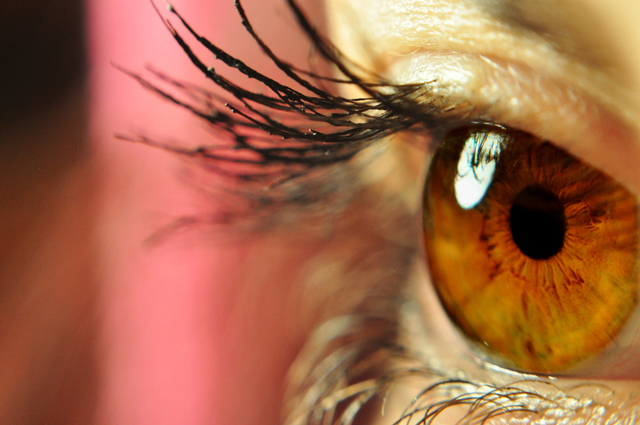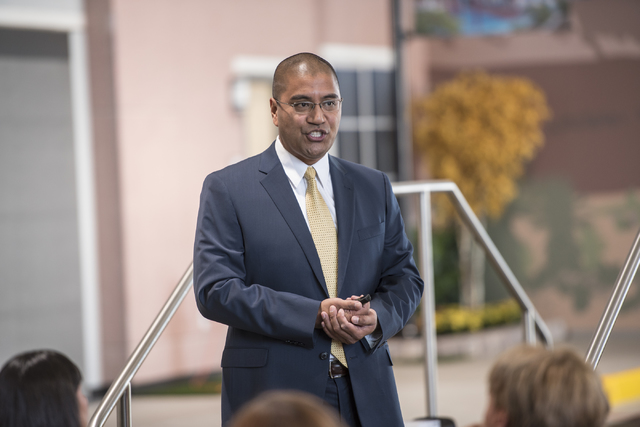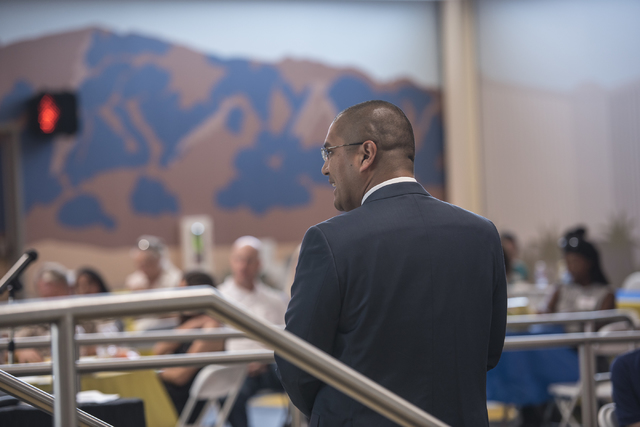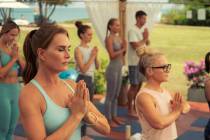Foundation Fighting Blindness sponsors VisionWalk to support efforts
Jason and Sandra Kuzik are racing to do all they can to cure blindness. As co-chairs for VisionWalk Las Vegas, a Nov. 6 walk to benefit the Foundation Fighting Blindness, they’re signing up volunteers and teams of participants, soliciting raffle prizes and spreading the word to support a cause that, for them, hits close to home.
Two of Sandra’s uncles and a brother lost their vision as a result of retinitis pigmentosa, and she can’t just sit still as her youngest son, 15-year-old Jared, progresses down the same path.
Raquel O’Neill, speaking at a recent Foundation Fighting Blindness event at the Regional Transportation Center’s Mobility Training Center, said vision loss can be hard on everyone.
“When you lose your vision, your family members go through just as much anxiety and stress as you would because it’s the unknown,” she said.
Ophthalmologist Nelson Lopez of the Eye Clinic of Las Vegas spoke about retinitis pigmentosa and medical innovations in the works to fight it.
“The American Academy of Ophthalmology defines retinitis pigmentosa as not a single entity but a group of genetic disorders that impact the ability of the retina to process light and to give vision,” Lopez said.
In a healthy eye, light enters through the cornea in the front and travels to the retina where photoreceptors — rods, designed for night and peripheral vision, and cones, for day and centric vision — process the images and transfer the information to the optic nerve.
In a patient with retinitis pigmentosa, the rods and cones fail and die, resulting in a gradual decline in vision.
“We have identified, depending on the source, anywhere from 50 to more than 70 different genes that are mutated and can cause retinitis pigmentosa,” Lopez said.
He explained that a person’s DNA contains the code for all of the proteins necessary for life. When genes are mutated, it can result in proteins that are similar in structure but don’t function the same or even in proteins that are completely different from the intended protein.
“The bottom line is that these different proteins result in early death and early loss of these photoreceptors,” Lopez said.
The rods are typically the first to be compromised, resulting in vision loss in low light.
SIGNS OF DISEASE
Although many cases aren’t diagnosed until patients are in their teens, early signs include children who seem clumsy tripping over things in dimly lit rooms. They may also seem more sensitive to light and close their eyes tightly in bright sunlight. Some insist on wearing sunglasses all the time, even indoors.
Lopez said another sign is when children have difficulty adapting to dark environments.
“This would really show up at bedtime, when the room lights go off and they have difficulty seeing,” he said.
As patients age, they lose more rods, which results in night blindness followed by a loss of peripheral vision.
“As peripheral vision loss continues, this is a term I think everyone has heard, their vision turns into a tunnel,” Lopez said. “Really only being able to see a small, central, straight-ahead visual field. This vision loss unfortunately will continue to progress. It can progress to total blindness, although that is very rare. It can progress to a point where no light is even perceivable in one eye or both. But eventually central vision will be affected, where color perception, picking out details of images, reading, all of those things will be affected.”
He said most are legally blind by the time they are 40.
Sandra Kuzik said her brother stopped driving at 35, and now in his mid-50s is legally blind.
“We noticed Jared had it when he was 3 or 4 years old,” she said.
So far, the teen has issues only in low light.
“He’s learning to drive,” Sandra Kuzik said. “He drives fine in the day, but he can’t drive at night now. So even if we can just stop it.”
Sandra and Jason Kuzik never use the word blind, when describing Jared’s condition.
Jason Kuzik said they’re fine talking about it and answering any questions their son may have, but they aren’t about to “ram it down his throat.”
“It’s a balancing act for us,” Jason Kuzik said. “Knowing what to throw at him.”
Despite the prognosis, Jason Kuzik said his son has a great sense of humor about the situation and even jokes that when considering girlfriends, he’d do best to find one who can drive.
Retinitis pigmentosa is passed on genetically on the X chromosome. While women are carriers, the disease rarely manifests itself in them. A father with it has a 50-50 chance of passing the trait on to his daughter. A woman who is a carrier has a 50-50 chance of passing it on to her children.
“We almost got lucky,” Sandra Kuzik said, “We had three that didn’t get it.”
They’re hoping they are fortunate again and a cure is developed before it’s too late for Jared.
Research, clinical trials
“Unfortunately, at this time there is no cure for retinitis pigmentosa,” Lopez said. “I hope within my lifetime that I am able to see patients with blindness get their vision restored. I think every day we get closer and closer and closer to that.”
Lopez said one promising treatment in clinical trials is gene therapy.
“What happens is DNA for a normal protein is actually built into a virus,” he explained. “And this virus is used to attach that DNA to cells within the retina. Those normal genes, in theory, would be able to start making normal proteins. With these normal proteins, if they’re able to get in high enough concentration into the retina, it should allow those retina cells to function better to live their normal life span, so that even though it may not cure the disease it may stretch out the useful vision by decades.”
The Foundation Fighting Blindness cited several retinitis pigmentosa research advances in a packet distributed at the event.
Gene therapy helped 40 children and young adults with a severe form of retinitis pigmentosa known as Leber congenital amaurosis caused by mutations in the RPE65 gene restore some vision. A 10-year-old put his white cane away and can now see the blackboard at school and a young woman was able to see fireflies for the first time thanks to the trials at The Children’s Hospital of Philadelphia, Moorfields Eye Hospital in London, the Universities of Pennsylvania and Florida and other centers around the world. The Children’s Hospital of Philadelphia trial has expanded to the University of Iowa and spun off into Spark Therapeutics, a company focused on commercializing the treatment and gene therapies for other ocular diseases.
Another clinical trial is tapping Valproic, a drug used in seizure disorders, to preserve vision in people affected by some forms of retinitis pigmentosa. A 90-participant study is being conducted through the Foundation Fighting Blindness’ Clinical Research Institute.
A gene therapy research collaboration between the Institut de la Vision in Paris and the Friedrich Miescher Institute in Basel, Switzerland, is striving to improve the health of cones and their lifespan.
University of Florida researchers are working on a gene therapy to fight autosomal dominant retinitis pigmentosa caused by variations in the rhodopsin gene. Part of the challenge with autosomal dominant retinitis pigmentosa is that it’s not enough to deliver a healthy gene, the unhealthy gene needs to be turned off. In some cases they can override the bad gene with a good one in a one-step process, but in others they have to use a two-step process to take out the unhealthy gene and replace it with a good one.
Other groups are investigating treatment using everything from synthetic retinoids and dietary supplements to the transplantation of retinal progenitor stem cells.
PROLONGING SIGHT
In the absence of a cure, Lopez counsels his patients to do all they can to preserve their vision and to prepare for the worst while vision remains.
Though it has yet to be clinically proven, Lopez said many believe ultraviolet light and exposure to bright sun makes the disease progress more rapidly, so he recommends sunglasses outside, especially in Las Vegas’ sun. He also recommends a good healthy diet along with a daily multivitamin. As the disease progresses, he suggests adaptive technologies such as prism glasses to increase peripheral vision.
“We live with hope every day that they are going to find a cure,” Sandra Kuzik said. “For our son and for other people that have this as well as other vision problems.”
The Kuziks don’t know what to expect next. They are hoping a cure comes soon. But if it doesn’t…
“We do a lot of road trips to try to help him see everything he can now, just in case,” Sandra Kuzik said.
For more information, visit fightblindness.org/lasvegasvisionwalk.
Preview
What: VisionWalk Las Vegas
When: 9 a.m. Sunday
Where: Cornerstone Park, 1600 Wigwam Parkway, Henderson
Information: www.blindness.org

































